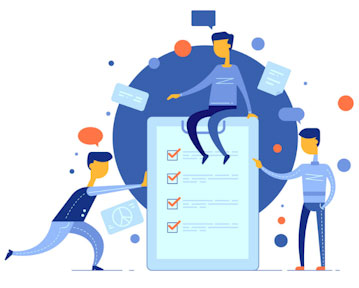About Us
We're Khamelia.com and we believe software should be useful, intuitive, and fast - so you can work better, get more accomplished and make smarter decisions for your company.
Headquartered in Folsom, California.
Khamelia is a powerful framework system that allows for the rapid development of integrated software tools, and resides on a very secure cloud, Microsoft Azure.
Imagine having a single platform that offers:
- Project Management
- Task Management
- Timesheet Management
- Document Management
- Time Tracking
- and more
All of which is made possible because it operates off of a proprietary framework – which has taken years to develop and perfect by our development team. All of the code that makes the functionality possible sits (one-time) at the framework level and is not scattered throughout the system at the software tool level. This not only simplifies the code for each individual tool, but it also keeps this highly integrated system lean and fast.
This may sound simple enough, but it’s also something which our competitors have not been able to do - nor will they be able to do it as robustly, securely, and powerful as we did. Once they start stacking software tools on top of each other like this, then their system becomes slow, unresponsive, and completely unusable.
"Cloud computing is the new norm; the cloud is here to stay"

We searched for a way to easily manage our consulting projects. We wanted a service that innovated with technology. We couldn't find one, so we decided to create our own business system that could help us run our business - and Khamelia.com was born.
Then Khamelia.com was embraced by other businesses as an advanced framework solution that was a useful, simple and a better way to work smarter, get more accomplished and make more informed decisions about their business.
Talking About the Cloud...
Software as a Service (SaaS) has a very bright future. Many leading organizations have already embraced SaaS cloud applications as the preferred way to deliver mission critical technology. SaaS has already established a strong position in the industry, and it's evolving rapidly. We see new advancements being made all the time. As people become more knowledgeable and familiar with SaaS, they will embrace new methods along with new ways of working.
We firmly believe that this will translate into sustained growth, increased spending and plenty of opportunities for development companies that provide leading edge SaaS solutions; and this is where Khamelia comes into the picture.
In the past, small to mid-sized businesses may have used 5-10 different software applications on any given day. Today they could use 25 or more to do their job; however, tomorrow they will only need to use one application - Khamelia.com
A Little Cloud History
The technology world is radically changing yet again due to cloud technologies, and the individuals and companies who position themselves for this massive shift, can benefit greatly. "In many areas, SaaS (cloud) has become the preferred delivery model," said Mr. Nag, senior researcher at Gartner. "Now SaaS users are increasingly demanding more purpose-built offerings engineered to deliver specific business outcomes." This is what the experts are saying... and that's what Khamelia offers.
Do you know that small and mid-sized businesses will spend approximately $1.0 trillion on software and/or software-related services every year? That's right - businesses need software and they're willing to spend the necessary money to get the required software in order to help run their companies.
Let's back up a bit. In the 1960's software was written to operate within large centralized mainframe computing environments. These mainframe systems were very complex. Companies like IBM created specialized software for their big corporate clients to use within their local mainframe-based computing facilities.
When Apple and Microsoft came into the market in the 1980's, they helped transition software formats from the large centralized mainframes to a more distributed computing server/desktop environment, that can be used on small office and home computers. This in return, has allowed companies like Microsoft and other distributed software companies to make hundreds of billions in revenue over the last 3-4 decades.
And now... With the arrival of the software-as-a-service (SaaS) environments, also called cloud services, companies are uniquely positioned to upgrade and transition many of their local (on-premise) server/desktop-based operations to the cloud, drastically reducing their IT (information technology) costs. This transition has launched a new industry, the cloud industry, with huge financial opportunities in the technology world.
In fact, financial and industry leaders are calling this the Next Big Thing within the IT industry where hundreds of billions of dollars will be spent on software for the cloud environment over the next five years alone.
Gartner inc, the world's leading it research and advisory company, has been tracking this new market demand since its beginning, where they have reported approximately $48.2 billion in revenue in 2016, and much more the following years, for software companies that are offering their software services from the cloud.
According to the Gartner Group, the worldwide SaaS cloud services is projected to grow over a 160% from 2016 to 2021. And this is only the beginning. Gartner is predicting exponential growth for the next 20 years.
...In the Beginning
In 1998, Gabriel Ungureanu, after working for many years for prominent companies in the Sacramento area decided to launch his own consulting firm. Gabriel then focused on web development and web applications projects, primarily for the State of California, County of Sacramento, and other public and private entities. Over the next two decades, Gabriel delivered many solutions for State of California departments and large private companies.
The Concept - Birth of the Khamelia Framework Concept
Gabriel was a senior developer on these efforts, and in doing so, noticed that the software programming was not as efficient as it could be. Gabriel began to formulate and tinker with the idea and concept of a framework written in the robust programming language C#. in his private time he started to focus on building a code repository and code library for this framework. The goal behind the code library was to reduce DRY (don’t repeat yourself) work, a new concept in web development at the time which has been formulated by Andy Hunt and Dave Thomas in their October 1999 book The Pragmatic Programmer.
Between 2000 and 2008, Gabriel was hired by the County of Sacramento, Department of Health and Human Services (DHHS) and others to set up their internet website and portal. Gabriel led the development teams in these efforts, and in doing so noticed how much better the use of the C# programming language would be for those applications.
C# was developed and released in 2000 by Microsoft within its .NET initiative and later approved as a standard by ECMA (ECMA-334) and ISO (ISO/IEC 23270:2006). C# is a powerful programming language, not a scripting or GLUE ‘language’ (which tend to be much less powerful, limited, less secure, and all GLUE languages are open-source).
The ECMA standard lists these design goals for C# (Wikipedia.com):
- The language is intended to be a modern, general-purpose, object-oriented programming language.
- The language, and implementations thereof, should provide support for software engineering principles such as strong type-checking, array bounds checking, detection of attempts to use uninitialized variables, and automatic garbage collection. Software robustness, durability, and programmer productivity are important.
- The language is intended for use in developing software components suitable for deployment in distributed environments.
- Portability is very important for source code and programmers, especially those already familiar with C and C++.
- Support for internationalization is very important.
- C# is intended to be suitable for writing applications for both hosted and embedded systems, ranging from the very large that use sophisticated operating systems, down to the very small having dedicated functions.
- Although C# applications are intended to be economical with regard to memory and processing power requirements, the language was not intended to compete directly on performance and size with C or assembly language.
- Design Patterns (MVC Architecture) – Model–view–controller (MVC) is an architectural pattern commonly used for developing user interfaces that divides an application into three interconnected parts. This is done to separate internal representations of information from the ways information is presented to and accepted from the user.
After DHHS, Gabriel was contracted out to work on the State of California depart of Office of System Integration (OSI). OSI is tasked with providing a common project management methodology for all State entities to follow, and to provide State qualified project managers. Basically, OSI wants to be the overall PMO for the State of California. As Gabriel and team worked on the OSI projects, a functional trend was starting to be noticeable. Basically, the OSI was asking for much of the same functionality that DHHS requested, but with modified fields and workflows. These were needed in order to cater to the hundreds of OSI forms that CA State departments had to complete. So the major difference between DHHS and OSI was mostly customization of fields and workflows, in order to meet OSI business processes.
After OSI, Gabriel went to work for State of California Office of Health Information Integrity (OHII) department. Again, the same experience between OSI and OHII, as there was between DHHS and OSI, basically same functionality, but added configuration and customizations to meet OHII processes. By this time, Gabriel could start to define a pattern in functionality requirements which could be addressed if these applications resided on his robust C# framework.
The Current Market and the Khamelia Advantage
Looking at the current market one can see a myriad of systems of all shapes and sizes. Each of these systems address specific functions around customer relationship management, project management, human resources, help desk and issue tracking, payroll, and more. But none of them are built from the foundation to be able to deliver all of these functions and tools in one system. This forces today’s businesses to procure and own a bunch of disparate stand-alone systems, each with its costs and requirements around:
- Licensing agreement
- Support / maintenance agreement
- Training requirements
- BC/DR (business continuity / disaster recovery) requirements
- Backup / data recovery
- Security requirements
- Change management requirements
- Manufacturer product lifecycle(s)
- Admin / administrative requirements
- ...and more
So multiply the above areas by each stand-alone system a company needs in order for day-to-day operations. It can get very costly. When we did the competitive analysis, we were astounded to find out how much certain companies were paying on a monthly basis for each user license and costs per stand-alone system. Let’s just say that it is a lot of money! And it is not just the cost, but all of these stand-alone systems are written and developed using different scripting languages (instead of a mature programming language such as C#), which then need to be integrated with each other in order meet minimum business operational needs. This greatly reduces visibility across systems, which in turn significantly limits decision-making capabilities at various management levels. And from a security perspective, the more systems a company has, the higher the security risk and risk to the company brand. The Khamelia advantage is that all of these business tools will reside on one system, the Khamelia framework, therefore all these functionalities will be highly integrated and homogenized. For one amazing low price!
About Khamelia.com:
- Launched in 2012 as a local on-premise business solution.
- Khamelia works on our adaptive business framework.
- Developed with Microsoft C# multi-paradigm programming language.
- Highly recommended by our current on-premise customers.






















